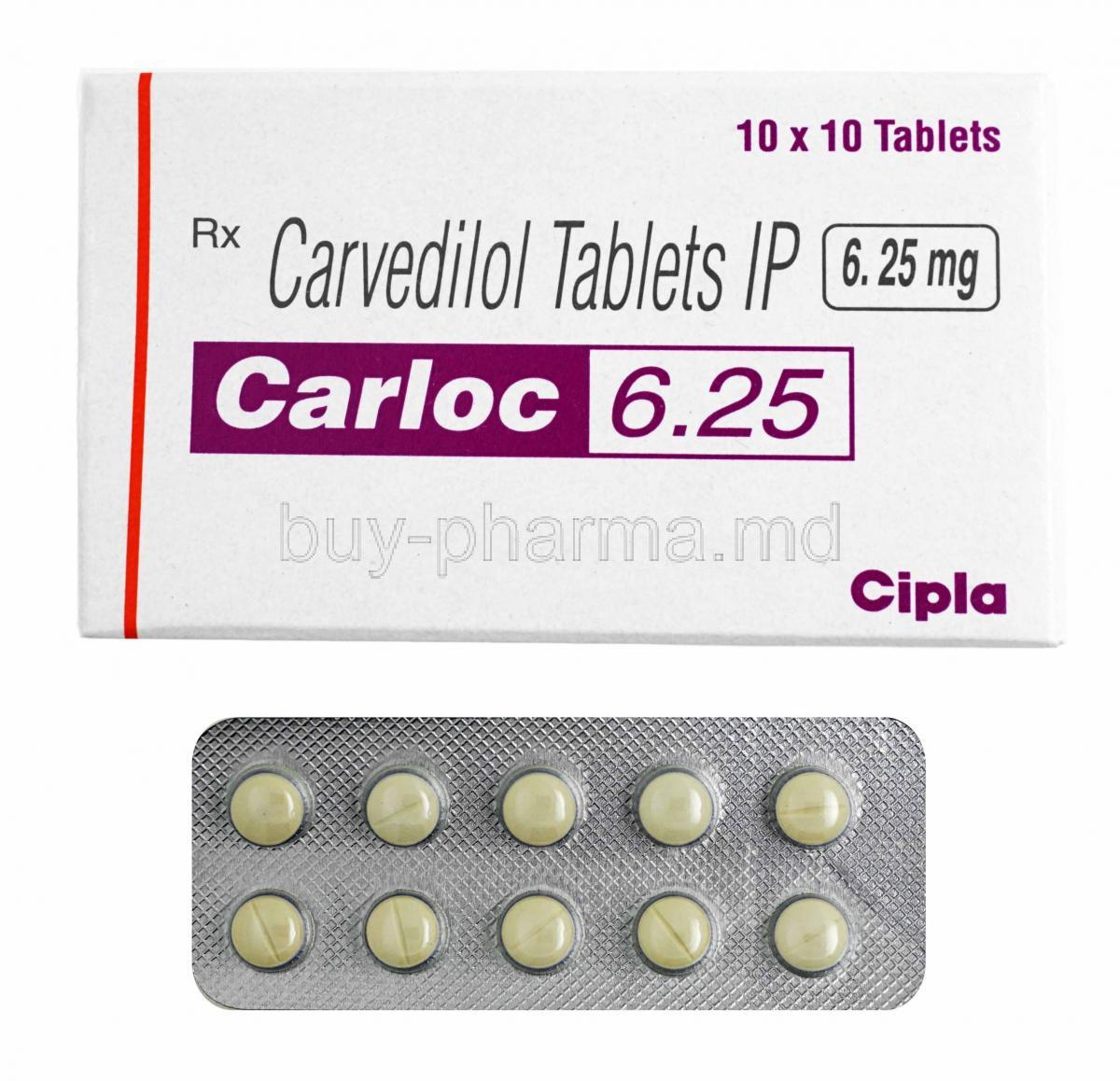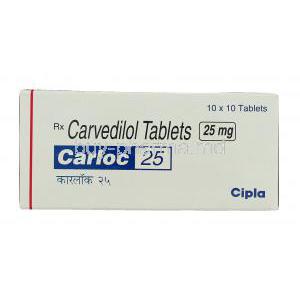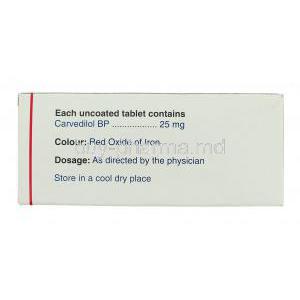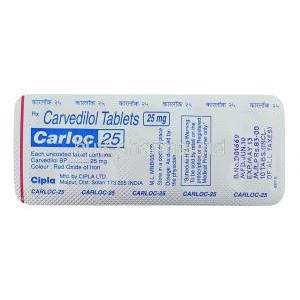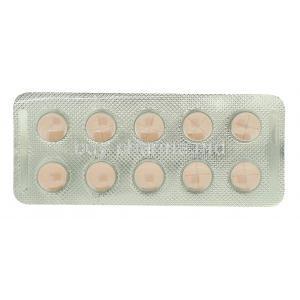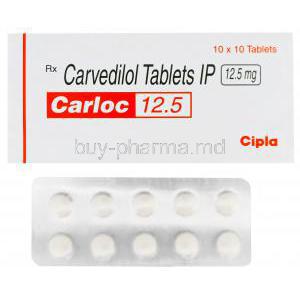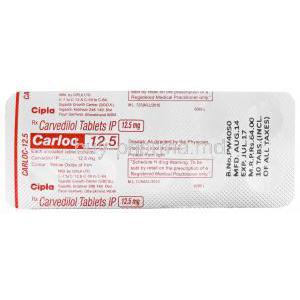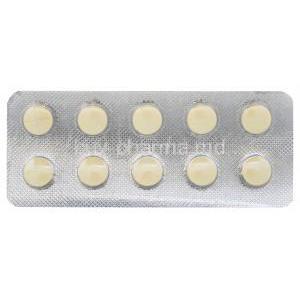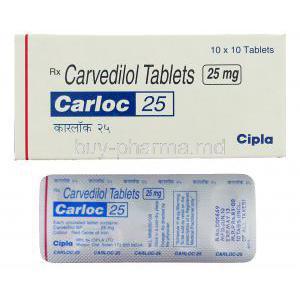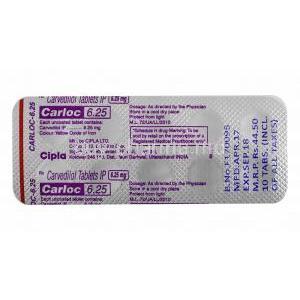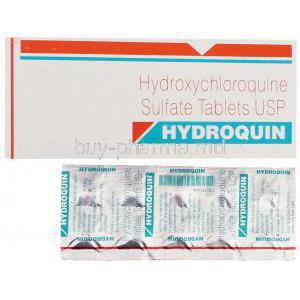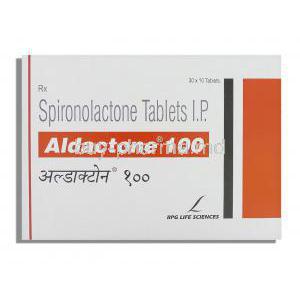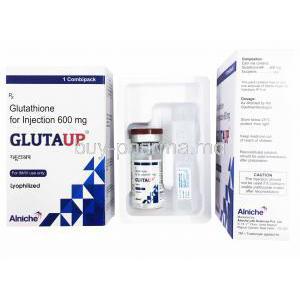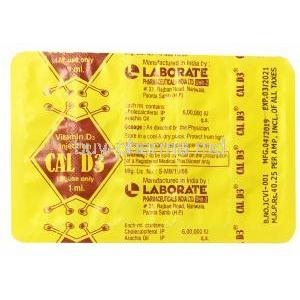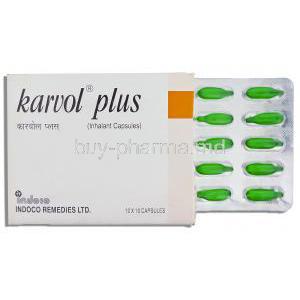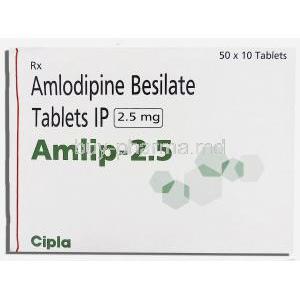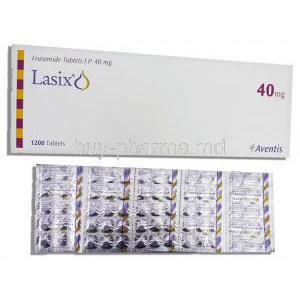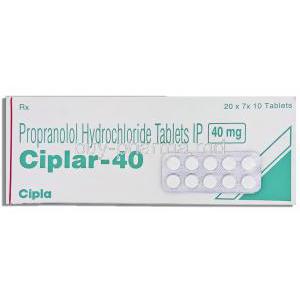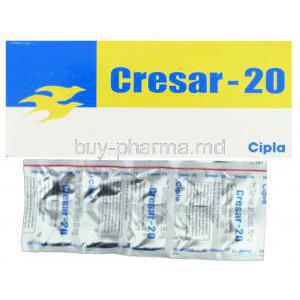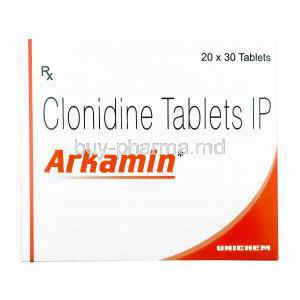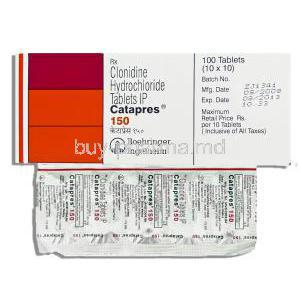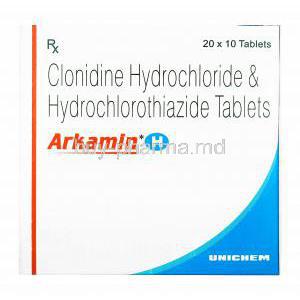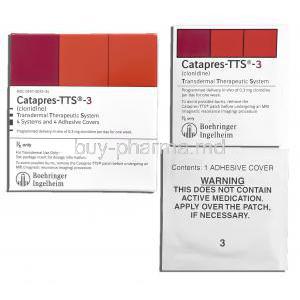Introduction to Carloc (Carvedilol)
Carloc, a brand formulation of the active pharmaceutical ingredient carvedilol, is a potent cardiovascular agent recognized for its dual action as a non-selective beta-adrenergic blocker with alpha-1 adrenergic blocking capabilities. It has earned a prominent place in the therapeutic landscape due to its ability to manage multiple cardiac conditions with efficacy and tolerability. Approved in the mid-1990s, carvedilol has undergone rigorous clinical evaluation, demonstrating significant benefits in reducing morbidity and mortality in patients with heart-related ailments. The medication’s relevance lies in its ability to optimize cardiac performance, control blood pressure, and improve patient survival following myocardial injury.
Composition and Formulation
The primary active ingredient in Carloc is carvedilol, chemically known as 1-(carbazol-4-yloxy)-3-[[2-(o-methoxyphenoxy)ethyl]amino]-2-propanol. This unique molecular structure enables both beta and alpha receptor antagonism. Carloc is available in multiple strengths, including 3.125 mg, 6.25 mg, 12.5 mg, and 25 mg tablets, as well as extended-release capsules for once-daily dosing convenience. Inactive components may include lactose monohydrate, magnesium stearate, povidone, and microcrystalline cellulose, all contributing to tablet stability and absorption characteristics. Packaging is typically blister-packed to ensure product integrity, with clear labeling to indicate dose strength and expiration date.
Mechanism of Action: How Carloc Works
Carloc exerts its pharmacological effects through simultaneous beta-adrenergic blockade and alpha-1 adrenergic blockade. By inhibiting beta receptors, it reduces heart rate and myocardial contractility, thus lowering myocardial oxygen demand. The alpha-1 blockade leads to peripheral vasodilation, reducing vascular resistance and aiding blood pressure control. This dual mechanism improves cardiac output without significantly increasing heart rate. Additionally, carvedilol possesses antioxidant properties, which help counteract oxidative stress in myocardial tissues, potentially preventing pathological remodeling after cardiac injury and prolonging long-term cardiac function.
Approved Medical Uses of Carloc
- Hypertension Management – Lowers systemic blood pressure and reduces cardiovascular risk.
- Chronic Heart Failure Treatment – Enhances left ventricular function and reduces hospitalizations.
- Post-Myocardial Infarction Therapy – Improves survival rates and limits cardiac deterioration.
- Angina Pectoris Prevention – Reduces the frequency and severity of chest pain episodes.
Off-Label and Emerging Uses
- Rate control in atrial fibrillation and other supraventricular arrhythmias.
- Prevention of variceal bleeding in patients with portal hypertension.
- Symptom control in hypertrophic cardiomyopathy.
- Adjunctive therapy for migraine prophylaxis.
- Management of tachycardia associated with thyrotoxicosis.
- Potential neuroprotective applications in Parkinson’s disease and certain dementias under research conditions.
Dosage and Administration Guidelines
Initial dosing depends on the clinical indication:
- Hypertension: Typically initiated at 6.25 mg twice daily, titrated upward based on response.
- Heart failure: Starting dose often 3.125 mg twice daily, gradually increased to the maximum tolerated dose.
- Post-MI: Initiated at low dose to assess tolerance before gradual escalation.
Maximum doses vary by indication, with upper limits generally around 25–50 mg/day. Administration with food is advised to slow absorption and reduce orthostatic hypotension risk. When transitioning from another beta-blocker, dose adjustments must be carefully managed to prevent withdrawal effects. Patients with renal or hepatic impairment require individualized dosing strategies.
Common Side Effects
- Fatigue and dizziness due to reduced cardiac output.
- Hypotension and postural lightheadedness.
- Bradycardia and cold extremities from decreased peripheral circulation.
- Gastrointestinal upset, including nausea and diarrhea.
- Mild weight gain and peripheral edema.
- Sleep disturbances with vivid dreams in some patients.
Potential Serious Side Effects
- Severe hypotension leading to fainting or shock.
- Worsening of pre-existing heart failure symptoms.
- Bronchospasm, particularly in asthmatic individuals.
- Conduction abnormalities such as atrioventricular block.
- Masked hypoglycemic symptoms in diabetic patients.
- Rare but serious allergic skin reactions.
Drug Interactions
- Calcium channel blockers (verapamil, diltiazem) – Risk of excessive bradycardia or AV block.
- Other antihypertensives and diuretics – Potential additive hypotensive effects.
- Antiarrhythmic agents (amiodarone, flecainide) – Increased risk of conduction disturbances.
- CYP2D6 inhibitors – Altered carvedilol metabolism leading to increased plasma concentrations.
- NSAIDs – May blunt antihypertensive efficacy.
- Insulin and oral hypoglycemics – Enhanced risk of hypoglycemia or masked warning signs.
Warnings and Safety Precautions
Carvedilol therapy requires vigilant adherence to safety protocols to minimize adverse outcomes. Abrupt cessation of the medication can precipitate rebound hypertension, angina, or myocardial infarction; gradual tapering over one to two weeks is strongly recommended. Individuals with bronchospastic disorders, such as chronic obstructive pulmonary disease or asthma, may experience exacerbation of symptoms due to beta-2 receptor blockade. Clinicians should weigh risks versus benefits in such cases.
Bradycardia and atrioventricular (AV) block are notable concerns, particularly in those with existing conduction abnormalities. Regular cardiac monitoring is advisable in at-risk patients. In peripheral vascular disease, carvedilol may worsen symptoms such as intermittent claudication due to reduced peripheral blood flow. Caution is also warranted in thyrotoxicosis, as carvedilol may mask tachycardia, a cardinal symptom, potentially delaying diagnosis or treatment of thyroid crises.
Contraindications
- Documented hypersensitivity to carvedilol or any excipients in the formulation.
- Bronchial asthma or related bronchospastic conditions due to risk of severe respiratory compromise.
- Severe bradycardia or advanced AV block in the absence of a pacemaker.
- Decompensated heart failure requiring intravenous inotropic therapy.
- Severe hepatic impairment where metabolism of the drug would be significantly compromised.
Careful Administration Considerations
Elderly patients often exhibit heightened sensitivity to the hypotensive effects of carvedilol; a cautious and gradual dose titration is necessary to reduce syncope risk. For those with renal or hepatic impairment, dose adjustments are imperative to prevent accumulation and toxicity. In diabetic patients, close monitoring is crucial, as beta-blockers can mask hypoglycemic warning signs such as tachycardia. Individuals with unstable cardiovascular conditions should avoid initiation until stability is achieved.
Special Population Use
Administration to Elderly Patients
Older adults face an increased likelihood of orthostatic hypotension, which can lead to falls and fractures. Regular blood pressure monitoring, especially during dose changes, is recommended. Lower starting doses and slower titration rates can help mitigate risks.
Administration to Pregnant Women
Carvedilol falls under a pregnancy safety classification that advises use only when the potential benefit justifies potential fetal risk. Limited human data exist, and animal studies have shown adverse effects. Careful obstetric consultation is advised before initiating therapy.
Administration to Nursing Mothers
Carvedilol may be excreted into breast milk, potentially affecting the nursing infant. If therapy is necessary, temporary breastfeeding interruption or substitution with formula feeding may be considered to prevent neonatal exposure.
Administration to Children
Pediatric safety and efficacy data for carvedilol are limited. Off-label use has been explored in specific cardiovascular disorders such as pediatric heart failure, but such administration should occur only under specialist supervision with careful dosing protocols.
Overdose Management
Overdose may present with severe bradycardia, profound hypotension, cardiogenic shock, and bronchospasm. Immediate medical intervention is critical. Management includes:
- Atropine for symptomatic bradycardia.
- Intravenous glucagon to enhance myocardial contractility.
- Vasopressor agents to restore adequate blood pressure.
- Supportive care with continuous cardiac monitoring and respiratory support if indicated.
Storage and Handling Precautions
Store carvedilol at controlled room temperature, ideally between 20°C and 25°C (68°F and 77°F), protected from moisture and direct light. Do not use beyond the expiry date indicated on the packaging. Unused or expired medication should be disposed of in accordance with local pharmaceutical waste guidelines to prevent accidental ingestion or environmental contamination.
Carloc, Carvedilol FAQ
- Is carloc the same as carvedilol?
- What is the best time to take carvedilol?
- What is carloc used for?
- What foods should you avoid while taking carvedilol?
- What is the most common side effect of carvedilol?
- Does carvedilol affect sleep?
- What are the benefits of taking carvedilol?
- What vitamins should you not take with carvedilol?
- How long does Carloc take to work?
- Can carvedilol cause anxiety?
- Can carloc cause weight gain?
- Can I drink coffee if I take carvedilol?
- Who cannot take carvedilol?
- What vitamins does carvedilol deplete?
- Can carvedilol make you tired?
- What is the warning for carvedilol?
- What is a good replacement for carvedilol?
- Is carvedilol and carloc the same thing?
- What happens when you stop taking carvedilol?
- Can you take carvedilol and amLODIPine together?
- How do you know if carvedilol is working?
- Can carvedilol help with anxiety?
- Why do doctors prescribe carvedilol?
- Does carvedilol cause insomnia?
- Why is carvedilol dosed twice daily?
- Does carvedilol cause hair loss?
- Does carloc make you sleepy?
- Can you exercise while taking carvedilol?
Is carloc the same as carvedilol?
Yes
What is the best time to take carvedilol?
If dizziness is a side effect, it's best to take it during bedtime.
What is carloc used for?
Carloc is used to treat hypertension, angina and heart failure.
What foods should you avoid while taking carvedilol?
Grapefruit, caffeine, and alcohol
What is the most common side effect of carvedilol?
- Allergy
- chest pain
- discomfort
- tightness
- lightheadedness, or fainting
- generalized swelling or swelling of the feet, ankles, or lower legs
- pain
- slow heartbeat
- trouble breathing
- weight gain
Does carvedilol affect sleep?
Yes
What are the benefits of taking carvedilol?
- Lower high blood pressure
- Lower risk of heart failure
- Lower risk of death
What vitamins should you not take with carvedilol?
No interactions were found between carvedilol and Vitamins.
How long does Carloc take to work?
Carvedilol usually starts to work after about 1 hour
Can carvedilol cause anxiety?
Yes
Can carloc cause weight gain?
Yes
Can I drink coffee if I take carvedilol?
No
Who cannot take carvedilol?
- People with allergic reaction to carvedilol
- Worsening heart failure
- Low blood pressure
- Liver problem
- Blood circulation problem
What vitamins does carvedilol deplete?
CoQ10, Melatonin
Can carvedilol make you tired?
Yes
What is the warning for carvedilol?
Risk of hypoglycemia (low blood sugar)
What is a good replacement for carvedilol?
Metropolol
Is carvedilol and carloc the same thing?
Yes
What happens when you stop taking carvedilol?
If you abruptly stop taking carvedilol, you might experience some withdrawal symptoms.
Can you take carvedilol and amLODIPine together?
Yes
How do you know if carvedilol is working?
Blood pressure is usually noticeably lower
Can carvedilol help with anxiety?
Yes
Why do doctors prescribe carvedilol?
To treat high blood pressure and heart failure
Does carvedilol cause insomnia?
Yes
Why is carvedilol dosed twice daily?
Carvedilol typically stays in your system for around 7 to 10 hours
Does carvedilol cause hair loss?
No
Does carloc make you sleepy?
Yes
Can you exercise while taking carvedilol?
Yes

